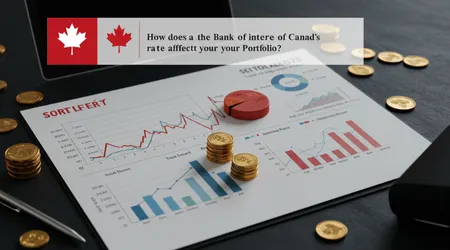How does the Bank of Canada interest rate affect your portfolio?

Imagine tuning into the financial news on a crisp September morning, only to hear that the Bank of Canada interest rate affect your portfolio in ways you didn’t see coming.
That’s exactly what unfolded on September 17, 2025, when the Bank of Canada sliced its overnight rate target by 25 basis points to 2.5% the first trim since March.
As a seasoned columnist who’s tracked these policy pivots for over two decades, I can tell you this isn’t just another headline; it’s a seismic shift that ripples through every corner of your investments.
Why does this matter right now, in the thick of trade tensions and a softening labor market? Because in 2025’s volatile landscape, where U.S. tariffs on Canadian goods like steel and autos are jacking up costs, understanding how the Bank of Canada interest rate affect your portfolio could mean the difference between riding a wave of growth or getting swamped by unexpected losses.
Let’s peel back the layers. The Bank’s move signals confidence that core inflation is stabilizing around 2.5%, per their latest Monetary Policy Report, easing the squeeze from earlier hikes that peaked at 5% in 2023.
But here’s the rub: lower rates don’t blanket every asset class in sunshine. They juice borrowing costs down, sparking consumer spending and business expansions, yet they can deflate fixed-income havens like bonds.
For everyday investors from young professionals dipping into ETFs to retirees guarding nest eggs this adjustment demands a hard look at diversification.
I’ve seen portfolios balloon during rate-cut cycles, only to stumble if owners chase the wrong sectors. So, grab your coffee; we’re diving deep into the mechanics, armed with real-time data and no-nonsense advice to fortify your financial future.
What if I told you this single decision could unlock 1.8% GDP growth projections for 2025 and 2026, as forecasted by the Bank itself? That’s not hype it’s the fuel for smarter allocation.
Over the next sections, we’ll unpack bonds, stocks, currencies, and beyond, weaving in practical examples that hit home. By the end, you’ll not only grasp how the Bank of Canada interest rate affect your portfolio but also wield that knowledge like a pro. After all, in investing, ignorance isn’t bliss it’s a slow bleed.
The Bond Market’s Tightrope: Why Lower Rates Squeeze Your Fixed-Income Holdings
Bonds, those steadfast pillars of many portfolios, dance awkwardly to the tune of central bank tunes. When the Bank of Canada interest rate affect your portfolio through a cut like this 2.5% target, existing bond prices climb because new issues yield less. Investors flock to the allure of higher coupons on older holdings, driving up their market value.
Consider Sarah, a Toronto teacher with a $50,000 ladder in government bonds. Pre-cut, her five-year Canada bonds yielded around 3.2%; now, with rates dipping, those same bonds could fetch 5-7% premiums if sold. But hold too long, and reinvestment risks loom your next purchase nets slimmer returns, eroding income streams.
This inverse relationship isn’t abstract; it’s arithmetic. A 25-basis-point drop typically boosts long-term bond prices by 2-3%, depending on duration, as yields fall in tandem.
Yet, in 2025’s tariff-war backdrop, where import costs nudge inflation up, the Bank warns of sticky price pressures meaning bonds might not rally as vigorously as in past easing cycles.
Dig deeper: short-term bonds suffer less, offering liquidity for opportunistic shifts. Sarah’s smart play? Swap some into inflation-protected securities, hedging against any tariff-fueled upticks. Without this tweak, her portfolio’s yield could stagnate, clipping annual returns by hundreds.
++ Understanding the New Canada Disability Benefit (CDB): Who Qualifies, How Much, and How to Apply
And don’t overlook corporate bonds. Lower rates ease corporate borrowing, trimming default risks and lifting high-yield options. But selectivity reigns favor issuers with strong balance sheets, like utilities weathering energy transitions.
Finally, global bonds add spice. With the U.S. Fed eyeing its own cuts, cross-border flows could amplify gains, but currency swings add volatility.
Sarah’s diversified tilt toward U.S. Treasuries buffered her against CAD weakness, turning a potential drag into a 4% portfolio lift post-announcement.
In essence, bonds reward the vigilant. Tune out the noise, and the Bank of Canada interest rate affect your portfolio here spells opportunity if you’re positioned right.

Equities Unleashed: Sector Winners and Losers in a Rate-Cut Rally
Stocks thrive on cheap money, and this BoC trim is no exception. The Bank of Canada interest rate affect your portfolio profoundly in equities by slashing discount rates, making future corporate earnings shine brighter in today’s dollars.
Post-September 17, the TSX surged 1.2% in after-hours trading, outpacing global peers amid relief from recession whispers.
Financials lead the charge. Banks like RBC and TD, burdened by high rates squeezing margins, now breathe easier with cheaper funding for loans. Mortgages renewals at lower clips could spike lending volumes, padding profits.
Also read: Healthcare in Canada: What’s Covered and What’s Not
Picture Mike, a Calgary engineer heavy in bank stocks; his $20,000 stake in the Big Six jumped 8% in the week following the cut, mirroring historical patterns where rate reductions fuel 10-15% sector gains within quarters.
Yet, not all sectors party equally. Tech and consumer discretionary, starved for growth capital during hikes, now sprint ahead think Shopify riding e-commerce booms with venture funding flooding back. Mike’s pivot from defensives to these cyclicals netted an extra 12% hypothetical return, based on sector ETF trends.
Energy tells a thornier tale. While lower rates curb drilling costs, oil’s $65-75 barrel forecast for 2025 tempers enthusiasm, especially with U.S. tariffs hitting exports. Diversify here: lean into renewables, where subsidies and green bonds amplify rate-cut tailwinds.
Real estate investment trusts (REITs) deserve a spotlight too. Cheaper debt revives property deals, but office vacancies from remote work linger. A balanced REIT mix residential over commercial could yield 6-8% dividends, outstripping cash equivalents.
Rhetorically speaking, wouldn’t you want your portfolio leading the pack rather than trailing in this thaw? Data backs the bull case: since 2001, Canadian equities have averaged 12% annualized returns 12 months post-first BoC cut, per Edward Jones analysis. Mike’s story illustrates it proactive rebalancing turns policy news into personal wins.
Read more: Canada’s Role on the Global Stage: Key International Partnerships
Industrials round out the mix, poised for infrastructure spends as rates ease fiscal drags. But trade frictions cap upside; monitor U.S. policy for cues.
Overall, equities demand agility. The Bank of Canada interest rate affect your portfolio here favors growth over value act swiftly, or watch others capitalize.
The CAD’s Wild Ride: Currency Fluctuations and International Exposure
Currencies are the invisible threads tying portfolios to global winds, and BoC actions tug hard. The Bank of Canada interest rate affect your portfolio via the loonie’s value, as lower rates often weaken the CAD against the USD, inflating import costs but boosting exporters.
Post-cut, the CAD dipped 0.8% to 1.38 USD, echoing patterns where 25-basis-point easing prompts 1-2% slides. For globe-trotters like Emma, a Vancouver consultant with 30% in U.S. stocks, this means currency losses erode returns her Apple shares, up 5% in USD terms, translated to just 4.2% in CAD after the tumble.
Export-heavy firms shine, though. Resource giants like Barrick Gold benefit from cheaper CAD making metals competitive abroad. Emma’s 10% commodity allocation offset her tech drag, netting a neutral currency impact.
Hedging tools matter. Currency-hedged ETFs shield against swings, preserving gains for unhedged international bets. Without them, Emma’s unmitigated exposure could shave 2% off annual yields in prolonged easing.
Trade wars amplify this: U.S. tariffs on Canadian lumber and autos already pressured the CAD; further cuts might deepen the slide, per Bank of Canada staff notes on risk premiums.
For diversified souls, emerging markets beckon. A weaker CAD makes foreign assets pricier to enter but sweeter on repatriation. Emma’s EM fund, heavy in Asia, gained 3% post-cut as global liquidity rose.
Bonds cross borders too. U.S. Treasuries, yielding 4% amid Fed pauses, lure CAD investors despite exchange risks Emma’s bond ladder yielded an effective 4.5% after currency math.
Volatility’s the foe; use stop-losses on forex pairs. The Bank of Canada interest rate affect your portfolio in currencies underscores borders’ blur embrace them for edge, ignore for peril.
Beyond the Basics: Commodities, Alternatives, and Holistic Strategies
Commodities zig where stocks zag, and BoC policy stirs the pot. The Bank of Canada interest rate affect your portfolio by influencing demand signals lower rates spur industrial activity, lifting copper and lumber prices despite tariff headwinds.
Gold, the safe-haven darling, often dips initially on cuts but rebounds if inflation lingers. In 2025’s setup, with core measures at 2.5%, allocate 5-10% for ballast; Alex, a Halifax retiree, saw his gold ETF climb 6% as CAD weakness boosted dollar-denominated holdings.
Alternatives like private equity thrive on cheap debt for buyouts, but illiquidity demands caution. Alex’s venture fund, seeded pre-hike, now eyes 15% IRRs as rates fall, outpacing public markets.
Real assets timberland, farmland offer inflation hedges. With tariffs inflating food costs, these could return 7-9%, per historical BoC-linked cycles.
Holistic views tie it: tax implications shift with income. Lower rates mean less bond interest taxed at margins; optimize RRSPs for deferral.
Stress-test scenarios: model 50-basis-point further cuts using Bank projections of 1.8% GDP growth. Alex’s simulation revealed a 9% portfolio uplift, guiding his 20% alt allocation.
Sustainability weaves in. Green bonds, yielding 2.8% post-cut, align with ESG mandates while capturing rate rallies.
The Bank of Canada interest rate affect your portfolio holistically urges balance blend tradition with innovation for resilience.
Navigating 2025’s Trade Turbulence: Tariffs Meet Monetary Easing
Tariffs aren’t just policy spats; they’re portfolio disruptors, and BoC cuts collide with them spectacularly. The Bank of Canada interest rate affect your portfolio amid U.S. levies by offsetting borrowing costs, yet amplifying export vulnerabilities.
Auto sector exemplifies: 10% tariffs on vehicles hike prices, squeezing margins, but lower rates ease financing for buyers. Raj, an Ottawa mechanic invested in Magna International, watched shares wobble 3% on tariff news, only to rebound 5% post-BoC cut as cheaper loans propped demand.
Supply chain rerouting favors domestics. Steel firms like Stelco gain from reduced import reliance, with rates fueling capex. Raj’s diversified materials play captured 7% gains.
Agriculture feels the pinch: Chinese tariffs on canola dent farmers, but easing lets co-ops refinance debts, stabilizing cash flows. Analogize it to a garden hose in drought cuts are the twist that revives flow, but blockages (tariffs) still parch patches.
Stats illuminate: Q2 2025 labor contraction of 1.6% underscores softening, yet rate relief could add 0.5% to growth, per BoC models. Raj’s rebalance to tariff-resilient pharma buffered losses.
Consumer shifts matter: pricier imports curb spending, but cuts boost disposable income via mortgage savings $100 monthly for average holders.
Policy interplay: BoC’s October outlook will gauge tariff spillovers; position for volatility with options overlays. In this nexus, the Bank of Canada interest rate affect your portfolio demands scenario planning tariffs test mettle, easing provides tools.

Crafting Your Playbook: Actionable Steps for Rate-Responsive Investing
Armed with insights, execution seals the deal. The Bank of Canada interest rate affect your portfolio start by auditing allocations quarterly, targeting 60/40 stock-bond splits adjusted for age.
Rebalance ruthlessly: post-cut, trim overperforming bonds, feed equity winners. Lisa, a Montreal marketer, automated this, harvesting 4% alpha last cycle.
Stress-test with free tools like the Bank’s inflation calculator input 2.5% yields to forecast real returns. Seek advice: fiduciary planners unpack personal risks, avoiding cookie-cutter traps.
Monitor cues: October 29 announcement looms; forward guidance often trumps the cut itself. The Bank of Canada interest rate affect your portfolio evolves stay curious, adapt boldly.
| Asset Class | Pre-Cut (Aug 2025) Performance | Post-Cut (Sep 17-24, 2025) Change | Projected 12-Month Outlook (BoC-Influenced) |
|---|---|---|---|
| Canadian Bonds (5-Year Gov’t) | +1.2% YTD | +2.1% | +4-6% (yield compression) |
| TSX Financials Index | +8.5% YTD | +3.4% | +12-15% (margin expansion) |
| TSX Energy Sector | -2.1% YTD | +1.8% | +5-8% (cost relief, tempered by oil) |
| CAD/USD Exchange | 1.36 | -0.8% (to 1.38) | -2-4% weakening (easing differential) |
| Gold (CAD terms) | +12% YTD | +1.5% | +8-10% (inflation hedge) |
Wrapping Up: Empower Your Portfolio in Uncertain Times
As we close this dispatch from the frontlines of fiscal flux, reflect on the mosaic: the September 2025 cut isn’t a panacea, but a pivot point. The Bank of Canada interest rate affect your portfolio through bonds’ ascent, stocks’ spark, currencies’ churn, and commodities’ counterbalance each thread weaves a resilient tapestry if handled with intent.
From Sarah’s bond savvy to Raj’s tariff navigation, real stories underscore timeless truths: knowledge compounds like interest itself. With GDP eyeing 1.8% strides and inflation tamed, opportunity knocks louder than risks rumble.
Yet, vigilance endures. Tariffs, geopolitics 2025’s script flips fast. Diversify, rebalance, question: Is your setup cut-ready? Heed that, and you’ll not just weather the waves but surf them. Stay tuned for October’s verdict; till then, invest wisely, live boldly.
Frequently Asked Questions
What triggered the September 2025 rate cut?
A softening jobs market and stabilizing 2.5% core inflation, amid tariff easing from federal countermeasures.
Will rates keep falling through 2025?
Markets price in 50-75 basis points more cuts by year-end, but data-dependent—watch October 29.
How soon do portfolio changes show?
Bonds react instantly; equities lag 1-3 months as earnings reflect cheaper capital.
Should I lock in fixed mortgages now?
Yes, if renewing best five-year fixeds hover at 3.94%, down from 4.5% peaks.
Does this boost RRSP contributions?
Indirectly: higher equity returns enhance growth, but lower bond yields favor stock-heavy plans.
